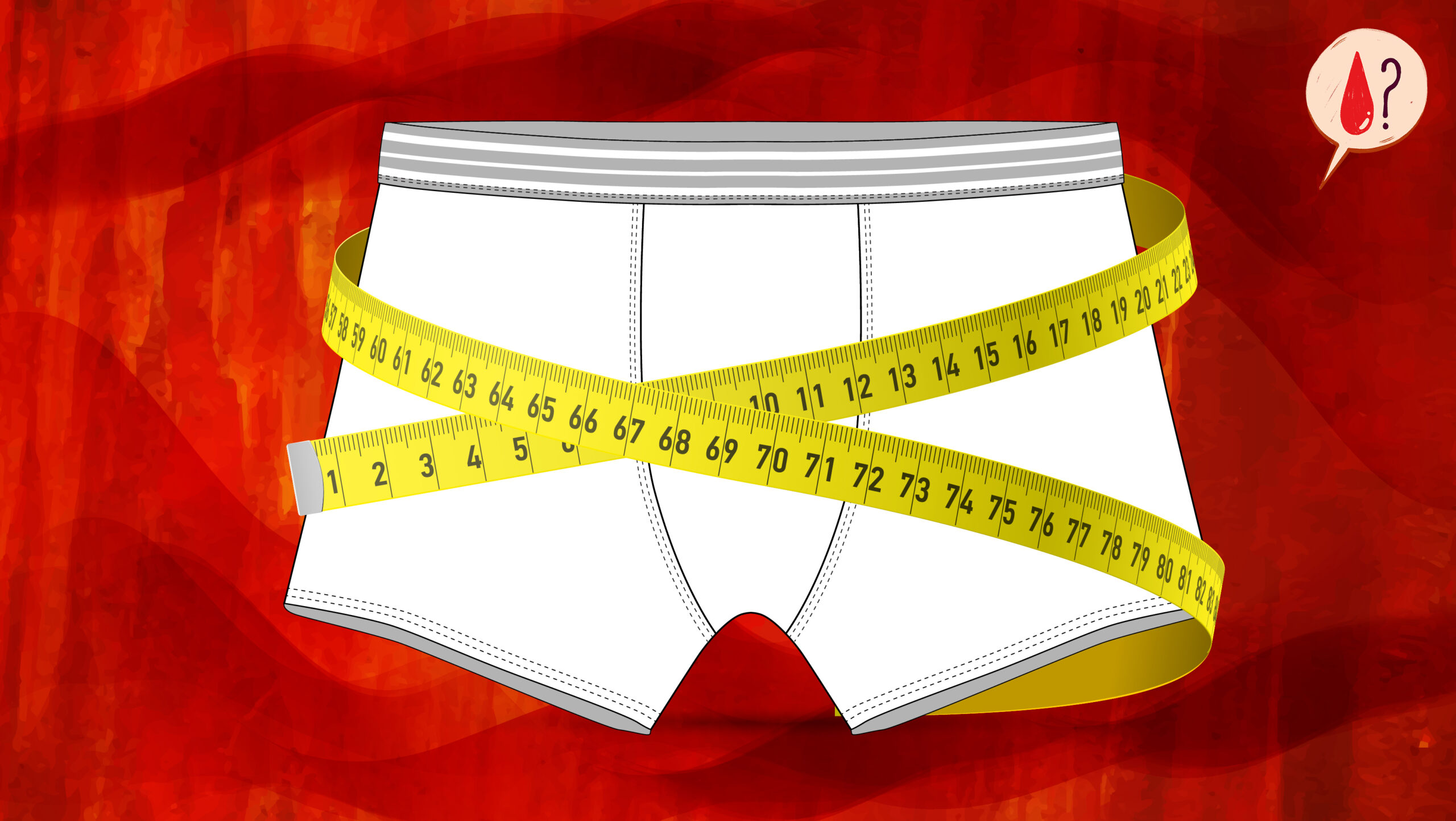This story is part of Seeing Red, a month-long series exploring periods from an LGBTQ2 perspective.
I’m fat. I’m non-binary. And I menstruate. But as the popularity of alternative menstrual products has expanded to include insertable cups, reusable pads and various kinds of period underwear, my choices as a shopper have not kept up. First, I have to search through styles I like, and then through styles I can tolerate, striving to find something that comes in my size. I also face constant misgendering, with garment designs that are coded feminine, and store advertising specifically directed at women.
I asked fellow fat folks in my body-positive networks about their own experiences with non-gendered menstrual wear. “I’m disabled, nonbinary and fat, so period undies would be a godsend — but as far as I can figure out, nobody at all makes any in my size,” Ricky from Melbourne tells me. “It’s infuriating that sexism and anti-fat sentiment and all the other crud combines in this way to limit choice.” Addressing the lack of available, accessible menstruation products became such an insurmountable challenge, she now suppresses her period with hormonal birth control.
Simone from New York City has had similar problems finding a fit and style that work, so she’s taken a DIY approach. “I have never found period panties I liked, even though I’ve found them in my size,” she says. She likes boxers and hipster briefs, but other common women’s styles that she’s purchased have been both expensive and poorly made. “It’s cheaper for me to buy cloth pads, but they only work in boxers if you sew them in.”
For most fat trans and gender non-conforming people, answering our bodies’ menstruation needs almost always means compromise. Stores that stock our sizes often misgender us. Retailers who have created shopping spaces that are safe for trans people usually don’t make clothing that fits us. “And when products are made that might actually fit, they’re regularly sold out,” Simone says.
Pyramid Seven produces period boxers for gender-diverse people, but have been sold out for months. Knix has a gendered website, addressing their advertising and targeting their products specifically to women, and their “dreamshorts” are frequently sold out. Both styles stop at XXL. ModiBodi in Australia, which currently ships to the United States but not Canada, has some styles up to a small 6x, fitting 56-58 inch hips. Their boyshort style, however, is currently only available in small and junior sizes.
Liana Lorenzato, the marketing and public relations director for ModiBodi, told me that the company is in the process of expanding this style up to a 2x or larger, but couldn’t confirm the size because the product is still in development. When asked about the gendered nature of their site, which offers their products to “all women” and discusses “lady parts,” she said they are “always looking to evolve to be inclusive for all people.” Pushed for specifics, she replied, “We feature our customers in our campaigns and will continue to encourage all of our customers, no matter their identification, to be represented.”
Over on Etsy, it appears even in the realm of custom handmade goods there are few options — I could find only one small-volume shop currently offering plus-size menstruation underwear and pads for diverse genders. Cute Fruit Undies in New York, which operates through Etsy and their gender-neutral website, has custom sizing options as well as regular sizes from extra-small to 5x. Their largest size, which has a 59-61 inch hip, is consistently in demand.
“For most fat trans and gender non-conforming people, answering our bodies’ menstruation needs almost always means compromise.”
The American company Thinx is well-known for their 2016 ad campaigns on New York City subways featuring trans male model Sawyer DeVuyst in their boyshort style. But this move towards more inclusiveness in period products makes it especially disappointing that their sizes stop at a very small 3x, with a 48-49.5 inch hip. (Representatives at Thinx did not respond to requests for comment.)
Lunapads, a Canadian operation based in Vancouver, took an early, strong stance about gender-inclusive language in December 2011 when they shared their plan to avoid gendering their customers in a blog post on their website. On their customer service page, the company has included a “Note on Trans Inclusion” that reads: “Lunapads users and staff include transgender, nonbinary, and genderqueer folks who span the gender spectrum. Our team is committed to providing an inclusive and welcoming space for *everyone* seeking better solutions to their everyday and monthly needs.”
In October 2017, Lunapads launched a boxer-brief style of menstruation underwear. Their sizes also stop at 3x, which is the size of regular underwear that I usually buy. Unfortunately, thanks to a lack of industry sizing standards, this number means very little. A Lunapads 3x measures 50-53.5 inches in the hips. My hips are 56 inches. On the other hand, Sara, a fat-activist acquaintance who lives on the unceded territories of the xmθkym (Musqueam), slilwta tmx (Tsleil-Waututh) and Skwxwú7mesh Úxwumixw (Squamish) Nations, known as Vancouver, wears jeans two-to-three sizes bigger than me — but Lunapads’ 3x boxers fit them perfectly. “My butt is big but my belly’s not and the gusset of most underwear sits too far back to be useful at all,” they say. The gusset on the Lunapads boxer-brief comes up almost to the waistband, which is exactly what Sara needs.
This discrepancy in fit demonstrates one of the biggest problems that fat people have with plus sizes: they tend to be modelled on sample sizes. A creator will make a small or extra-small garment, then expand its measurements proportionally up through medium, large, extra-large and maybe to a 2x or 3x. But fat bodies are not the same shape as thin bodies, and the former have a lot more diversity between them.
As Sara points out, “Slender people can have a really hard time grasping that there is way more variety in fat bodies than in not fat bodies.” If you’ve never had to hunt for a store that stocks clothing made for your body, it can be a difficult predicament to understand. It’s not as if, when one store’s largest size doesn’t fit us properly, we can simply skip off to another store offering a different cut or measurement. When you can count on one hand all the stores on the continent offering the items you need in plus sizes, and when they are all made for one specific shape of fat person, how do you deal with not being that shape?
Fat activists and self-advocates have been trying to engage with clothing companies to address sizing issues for years. Heather from Philadelphia tells me, “I have emailed several companies about the sizing and they always say something like, ‘Unfortunately, that’s the size range we are planning to make for the time being’ — even after I documented a discussion with dozens of people willing to preorder larger sizes.”
“Fat trans customers deserve to be able to access necessary menstrual underwear in retail spaces where all of our identities are respected.”
She contacted Thinx, Knix, Icon and Dear Kate about expanding their offerings to better suit her needs, and the needs of fat peers in her network of online groups. When she did receive responses, they usually just encouraged her to follow the companies on social media for future updates. But she doesn’t have to follow them — she regularly receives targeted ads on social media from some of these companies specifically aimed at plus-size people. “It is super frustrating,” she says, to get no response, or unsatisfactory responses, from retailers whose clothes don’t fit you, and then continue to be targeted by their advertising.
“There’s a lot of shame when people get something that’s too small for them,” Jane Hope, Lunapads’ marketing and communications manager, tells me. “I think there is a lot of cultural messaging that says, ‘It’s not the product that’s wrong. What you bought is right —your body is wrong.’”
I happened to speak with Hope just as Lunapads was making an important change. Spurred by feedback from customers over the years — hundreds of emails and social media messages, according to Hope — the company has worked not just to expand their size range, but to do so responsibly. They started by hiring plus-sizing experts to help them come up with a new design with fat bodies in mind.
“The sizing that we’re working towards creating would be based on XS to XL and then 1x to 5x, so it’s broken up into two separate size ranges,” production manager Megan Beveridge explains. Each of these ranges will be built on a unique base, perfected with feedback from fit models. For the expanded size range, they have worked with both a 1x and a 4x fit model, beta testers of sorts, who wear each of the items and offer suggestions for changes that might better serve plus-size customers. Hope says they’re projecting to begin offering their hipster style in 4x and 5x by this summer. By the end of 2020, they should be stocked up on freshly designed, expanded size ranges in all four of their available styles. It’s an expansion that could help push the market in the right direction towards understanding the need for more diversity within plus-size period underwear.
Fat trans customers deserve to be able to access necessary menstrual underwear in retail spaces where all of our identities are respected, but for most companies, our demands to be seen don’t seem to be enough. What if people who wore straight sizes only bought from companies that offer a full range of plus sizes as well? What if our needs couldn’t simply be brushed off as some hopeful fantasy? What if every garment maker accepted that it isn’t our shapes that are wrong, but their sizes? Having more size-inclusive period-proof underwear is only a small step toward fat justice. But it’s one step in the right direction.

This story is part of Seeing Red, a month-long series exploring periods from an LGBTQ2 perspective.


 Why you can trust Xtra
Why you can trust Xtra


